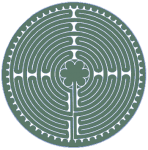 Anger management can be enhanced by walking a labyrinth this ancient tool can lower your blood pressure and help you control your anger. People walk the labyrinth for many reasons. Some do it to relax, some as a walking meditation, some just for fun. There are benefits to walking a labyrinth and controlling your anger.
Anger management can be enhanced by walking a labyrinth this ancient tool can lower your blood pressure and help you control your anger. People walk the labyrinth for many reasons. Some do it to relax, some as a walking meditation, some just for fun. There are benefits to walking a labyrinth and controlling your anger.
When you’re looking for a quick solution to reduce anger, take a walk. If you want to re-center and find serenity, walk a labyrinth.
If you have more anger in your life than you want—and who doesn’t—labyrinth-walking is one way to leave anger behind for a while. Perhaps the winding pathways resonate with the way our brains are wired. “Labyrinths seem to express a universal human impulse to create geometric patterns on the earth that can be traversed for the purpose of cultivating peacefulness, wisdom, and spiritual awareness.
Where are labyrinths located When you want to walk out your anger
Labyrinths are found all over the world in art, architecture, earth, and stone. Whatever their original purpose, the concept is meaningful enough to have lasted through the millennia, because labyrinths are still being created today in public parks, at schools, hospitals, or wellness centers, even in many backyards. Contrary to what you may think, a labyrinth is not a maze, at least not in the sense of something you might get lost in. According to the Labyrinth Society www.labryinthsociety.org, labyrinths are designed with a single path that leads into the center, and back out again.
In a world where many are running ragged and angry, we all need techniques to deal with anger and connect our inner and outer self. One such way to slowdown and deal with anger is to walk a labyrinth. Moving through a labyrinth is a form of walking meditation, and your body slows down when you reach a turn on the path. Walking to the centre of a labyrinth is walking to your centre.
What is a Labyrinth?
A labyrinth is a single path or unicursal tool for personal, psychological and spiritual transformation. Labyrinths are thought to enhance right brain activity and slow angry reactions real or imaginary stimuli. You enter a labyrinth through the mouth and then walk on the paths or circuits. The walls keep you on the path. The goal is in the center of the labyrinth. When you reach it, you have gone half the distance – you now need to turn around and walk back out.
[learn_more caption=”FEATURED LINKS”]
www.labyrinthsociety.org The Labyrinth Society, international organization, forum, events, gatherings, membership information.
www.labyrinthos.net Labyrinthos, Jeff and Kimerbly Saward, world’s greatest expert on labyrinths, British labyrinth journal Caerdroia
www.veriditas.net Veriditas: The Worldwide Labyrinth Project, the Reverend Dr. Lauren Artress, labyrinth locator list, facilitator training, Grace Cathedral.
relax4life.com/ Relax4Life, Neal Harris,IntuiPath double fingerlabyrinth
www.gwydir.demon.co.uk/jo/maze/index.htm Jo Edkin’s Maze Page, more than 60 illustrations of labyrinths
www.labyrinthina.com/path.htm Labyrinthina by Kathy Doore, extensive information
www.labyrinthresourcegroup.org Labyrinth Resource Group (Santa Fe), manual for working with labyrinths in schools
www.srlabyrinthfoundation.com Santa Rosa Labyrinth Foundation, Lea Goode-Harris, Ph.D.
www.constructingtheuniverse.com/ Timeless Wisdom, Michael Scheider’s page on sacred geometry
www.labyrinthguild.org Labyrinth Guild of New England
www.goldenspirit.com Chuck Hunner, jeweler extraordinaire and labyrinth construction blogs
www.johnjames.com.au The website of John James, expert on Gothic architecture
[/learn_more]